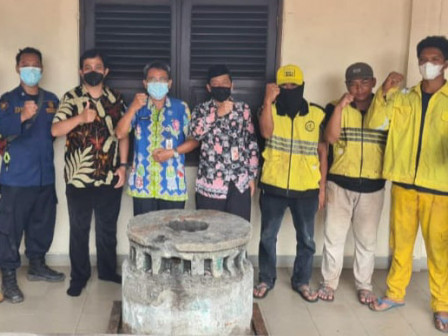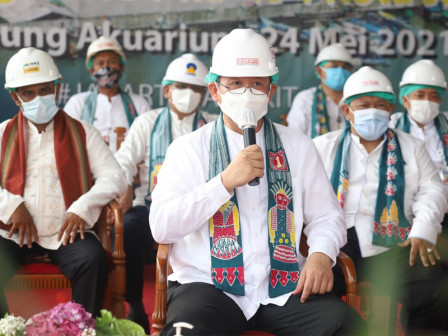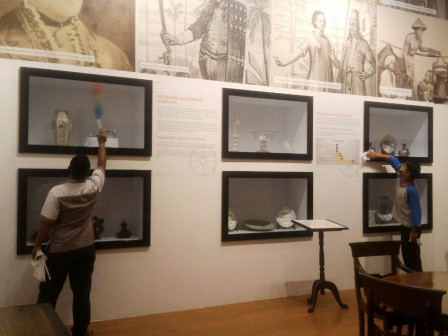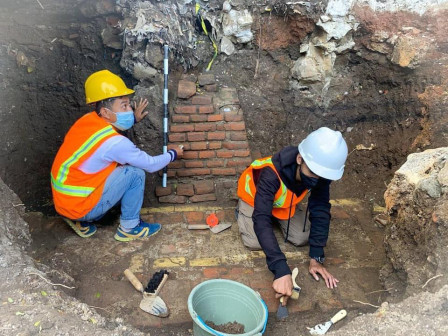Save Historical Assets, Dishub Evacuates Millstones to Condet Cultural Hall
Reported by Suparni | Translated by Nugroho Adibrata
Through the Cultural Conservation Conservation Center and the East Jakarta Culture Sub-agency, the Jakarta Culture (Disbud) Agency, evacuated the Milled Stone Suspected Objects (ODCB) from the sidewalks of Jalan TB Simatupang, Gedong, Pasar Rebo, East Jakarta, to the Condet Cultural Center, Balekambang, Kramat Jati, East Jakarta. It was thought to be from the 18th century.
Our purpose is to protect this historical asset
The Condet Cultural Center was chosen as the evacuation site, as it is close to its original location and its historical object can be more closely monitored and protected.
Culture Agency Head, Iwan Henry Wardhana stated, the evacuation was a protective measure in the form of saving the ODCB of the millstone, which was estimated to be hundreds of years old.
Discovery of Historic Stones on Jl. TB Simatupang will be Researched Further"Our purpose is to protect this historical asset, as it has been on the sidewalk that is prone to damage, either due to weather or acts of vandalism," he expressed, Friday (10/29).
He went on to say that the agency carried out the process of evacuating millstones together with various parties including the East Jakarta Bina Marga Sub-agency, East Jakarta Fire and Rescue Sub-agency, and Gedong Urban Village.
"We're very grateful for your assistance and cooperation regarding the evacuation process," he continued.
He explained, it would be conserved through cleaning and repairing the broken parts of the object, and then a narration would be given containing information about the history of the millstone.
"People can visit the Condet Cultural Hall to find out the history and story of the stone," he explained.
According to him, millstone is a sugarcane processing tool that is estimated to be used in the 17th-18th century AD. In the writings of Haan (1935:323-324), there is the term suikermolen which means sugar-making factory.
"In the 18th century, the term sugar mill referred to a sugar mill with simple traditional equipment that used stones to grind sugarcane," he assessed.
At that time, he added, sugar became one of the important commodities for trade in the world. Batavia is one of the sugar-producing sites, where the products are exported to China and Japan (Reid 2011:25, 30-31, 41-42)
Sugar production in Batavia was conducted by the Chinese who lived in the Chinatown area. Realizing that sugar production was profitable, the VOC finally made a stipulation that sugar in Batavia, which had to be sold to the VOC, but not to other parties. Even they determined the price of sugar (Lombard 2005: 248-249).
"The year 1710 was the peak of sugar production in Batavia, where there were 130 sugar factories owned by the Chinese, with most of them located around the Ciliwung River," he added.
But, after that, its production has decreased, which is indicated by the reduction of sugar factories. In 1738, there were only 80 sugar factories, 66 in 1750, and 44 in 1786 (Haan 1935: 324).
"We also found five other millstones in Milling Urban Village, Cakung Sub-district, East Jakarta. Locals call it "kiser stone/sugar cane millstone", which was used in the 17-18 century AD," he uttered.
After the decline in sugarcane production in Batavia and the exodus of the Chinese from Batavia in 1740, the Chinese began to build forts with high fences which were hereinafter called China Benteng.
One of them started to build a sugar cane mill to turn into granulated sugar in Cakung. The origin of the name of the milling village also came from the name of the milling stone. It was previously called Kampung Cakung, which was known as Kampung Gula (Sugar Village).
"Until today, one of the other millstones is also in the Jakarta History Museum," he stated





